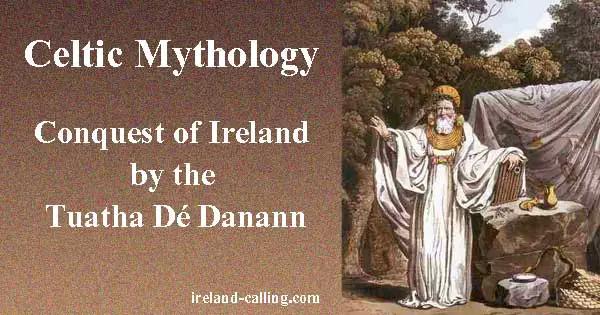The Tuatha Dé Danann are probably the best known of the mythological tribes who were said to have invaded Ireland during its ancient past. Their story is told in the Book of Invasions, the history of Ireland compiled by Irish scholars in the 11th century.

The Book was originally intended as an accurate history of Ireland but it is now widely regarded as being almost entirely mythical. It contains some of Ireland’s richest folklore.
Tuatha Dé Danann means the “people of the goddess Danu’. Like the Fir Bolg, they too were said to be the descendants of Nemed who had led a led an invasion of Ireland several hundred years earlier.
According to legend, the Tuatha came to Ireland on clouds from the north, or on ships which they burnt as soon as they landed to make sure they couldn’t retreat.
The Tuatha defeated the Fir Bolg to take control of Ireland but like many groups of invaders before them, they too found themselves under constant attack from the fierce semi-divine tribe known as the Fomorians.
They survived, however, and were later credited for having brought both druid law and chariots to Ireland.
The Milesians and the fall of the Tuatha Dé Danann
The Tuatha Dé Danann were eventually defeated and replaced by a final wave of invaders. These were the Milesians, the Gaelic people who are first mentioned towards the beginning of the Book of Invasions.
These are the people descended from Goidel Glas, who created the Gaelic language following the fall of the Tower of Babel in the bible.
His people eventually settled in Galicia in north west Spain where they become known as Gaels. One of his descendants, Íth, sees Ireland from the top of Breogán’s Tower in the town of Brigantia (modern day Corruna). He goes to Ireland to see if it is as habitable as it appears but he is killed by the Tuatha Dé Danann.
His uncle, Míl Espáine, sets out to avenge his death and conquer Ireland. As Míl marches towards Tara, the ancient seat of Ireland’s kings where he intends to take control, he is greeted by three sisters Banba, Fodla and Ériu,
They are the queens of Ireland’s three co-rulers. They each ask Míl to name the country after them if he is successful. Míl promises to do so.
He fights several battles against the Tuatha Dé Danann, drawing on both military prowess and magic spells. He is successful and Ireland is conquered. Defeated, the Tuatha Dé Danann flee to the otherworld and become the fairy people of Irish folklore.
Míl keeps his word to the three sisters and Ireland is named after all of them, but Ériu was the one to be most commonly used.
Míl Espáine’s descendants became known as the Milesians, the people from Galicia who became the Gaelic ancestors of the Irish people.